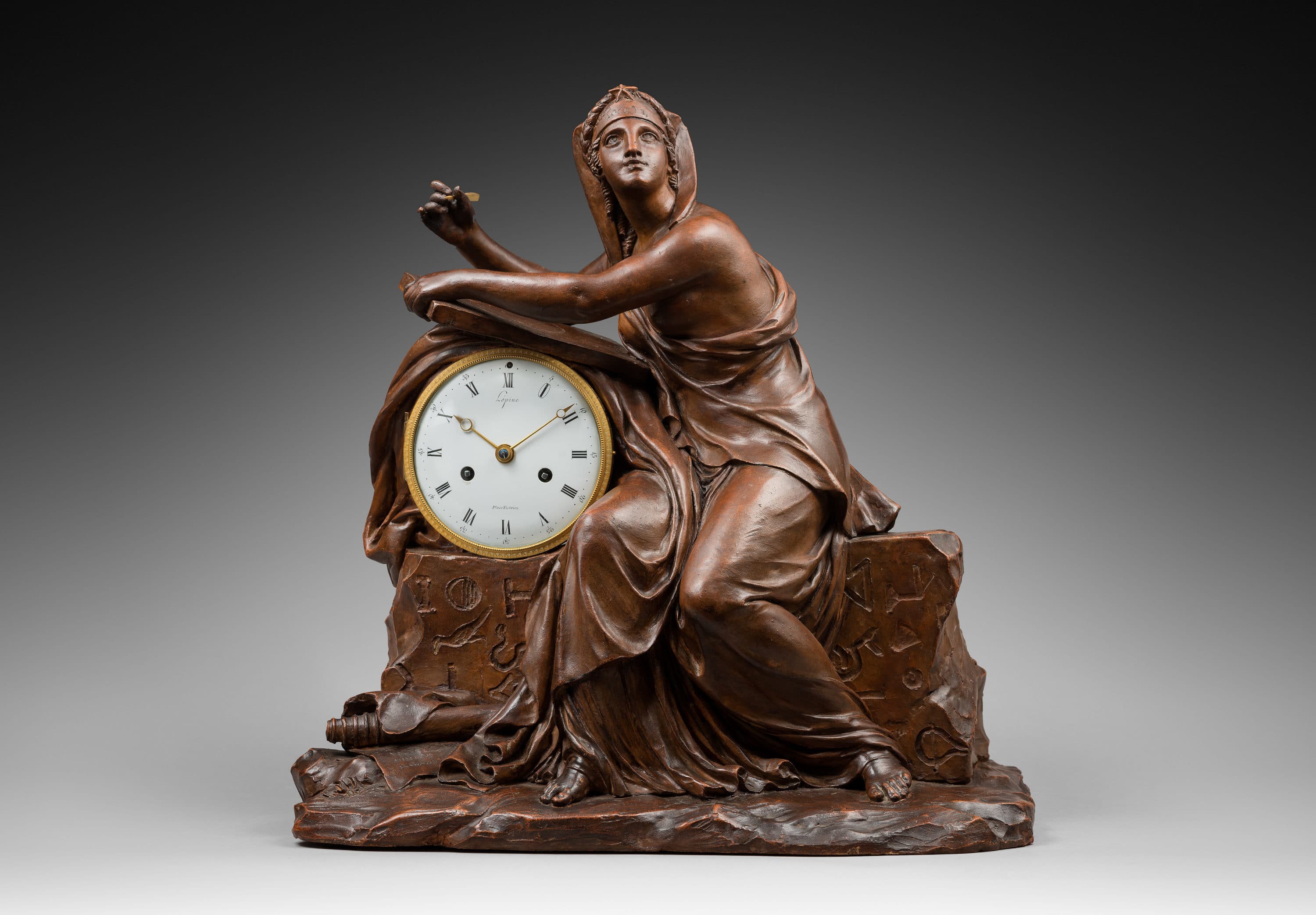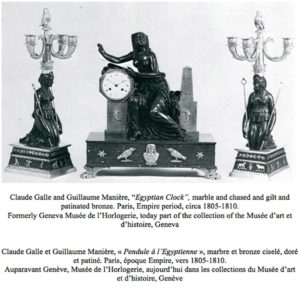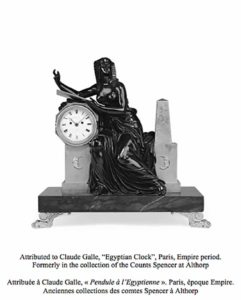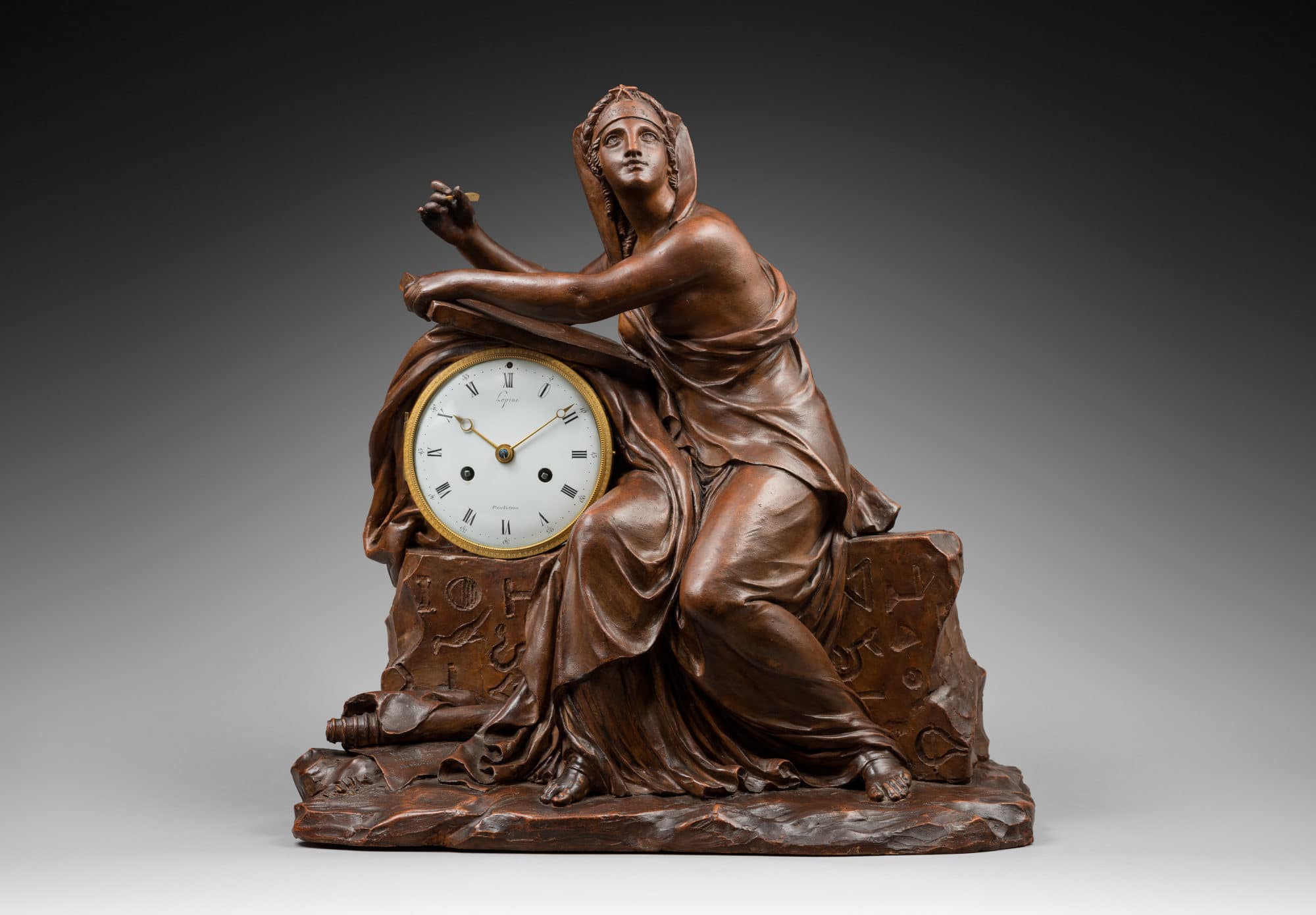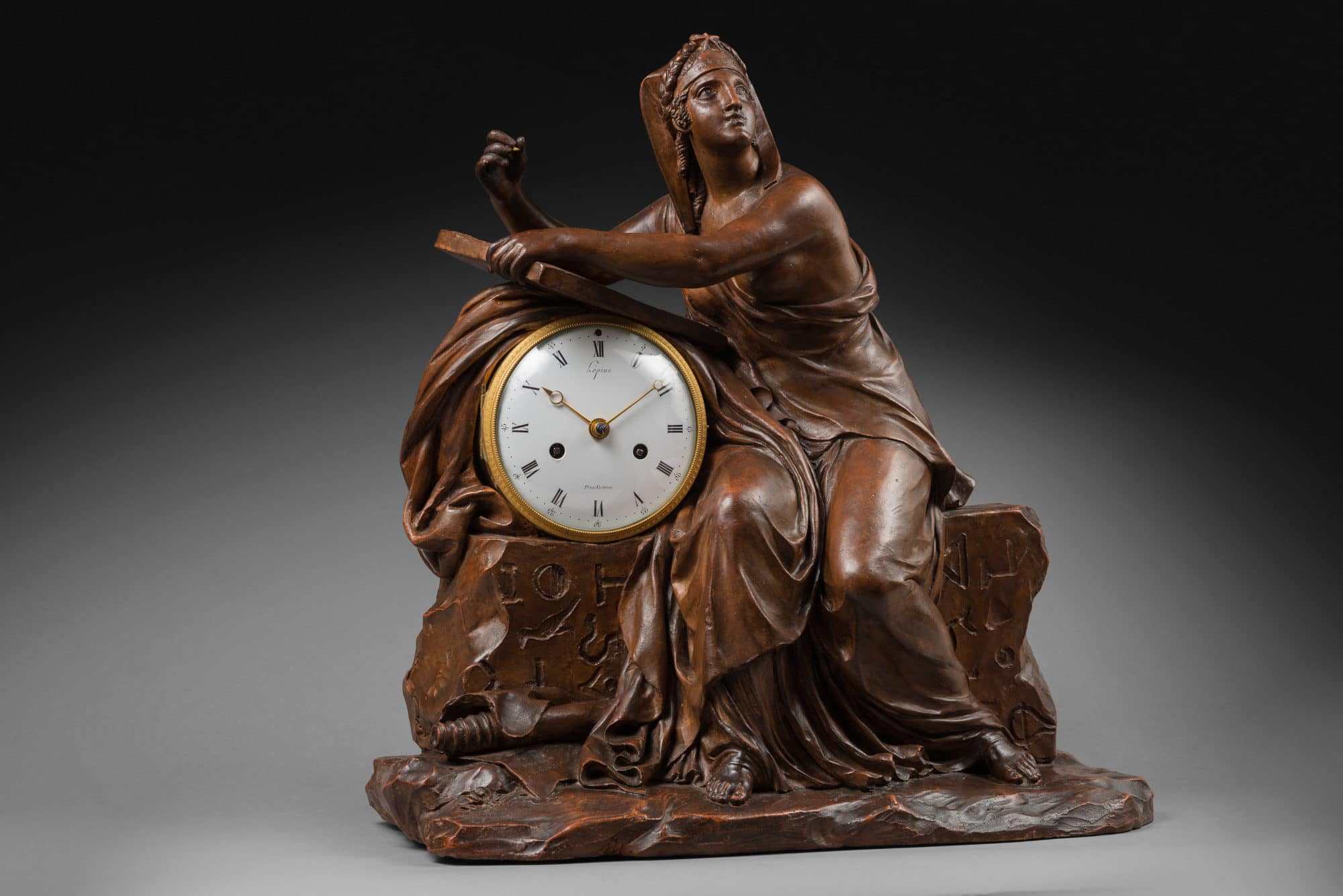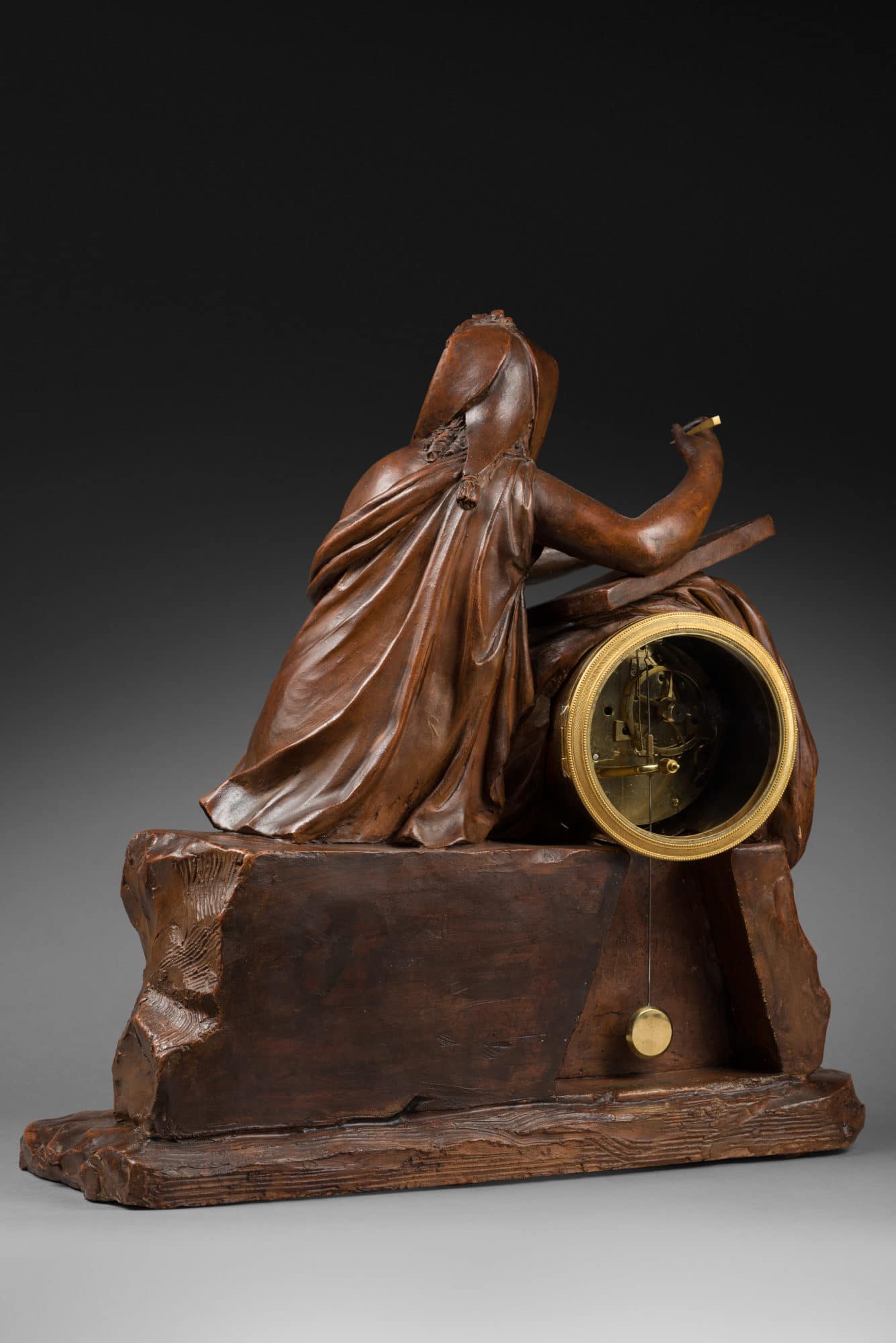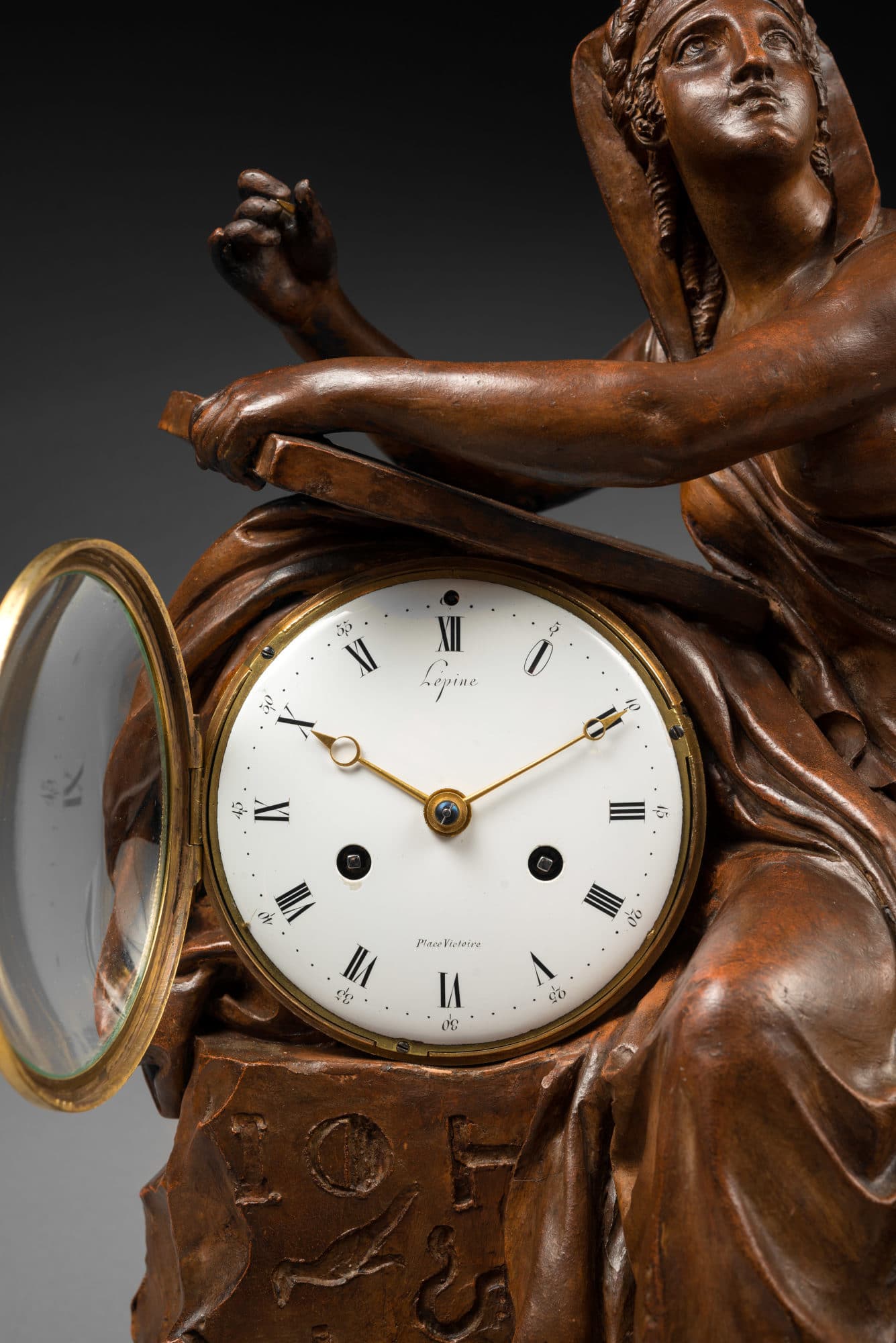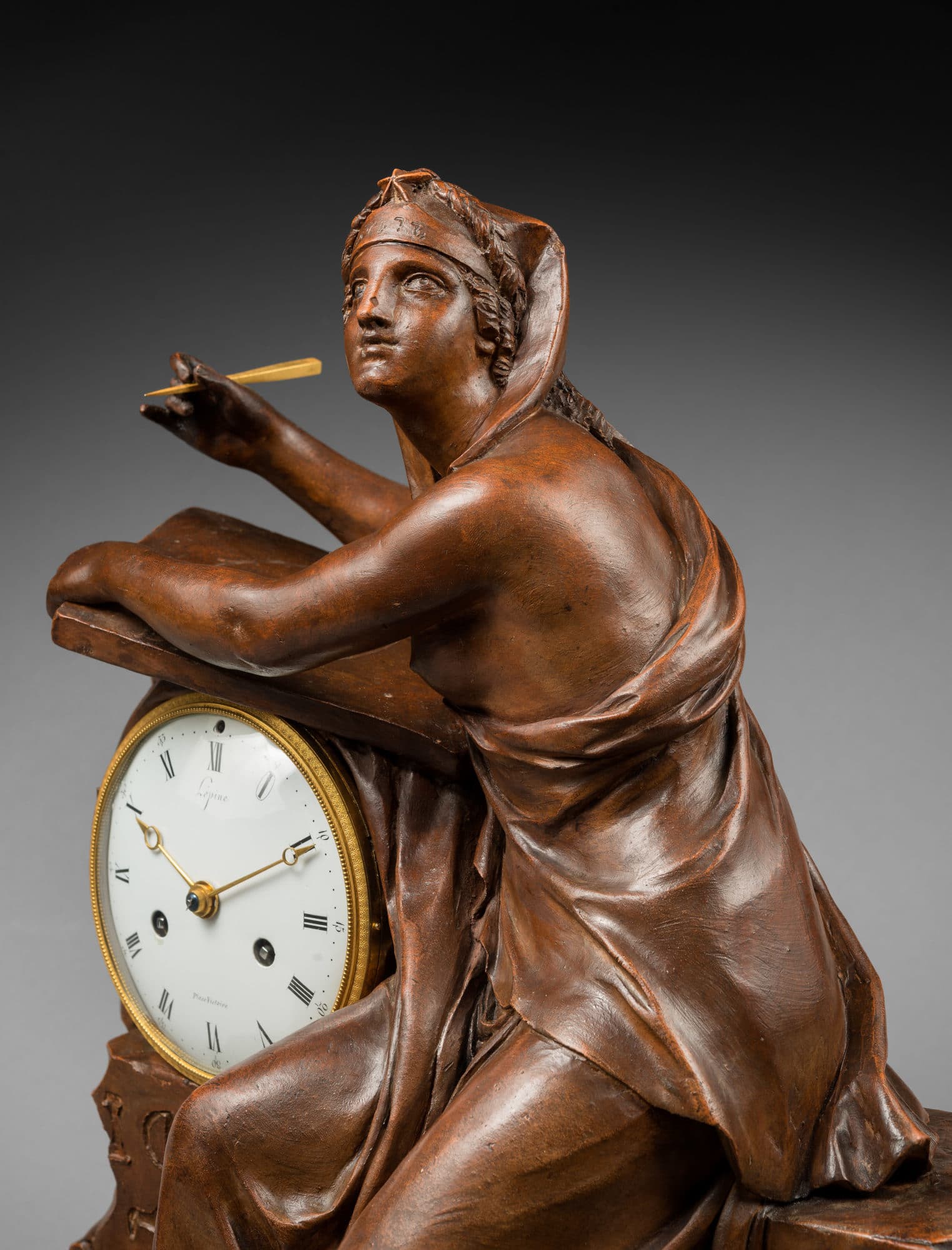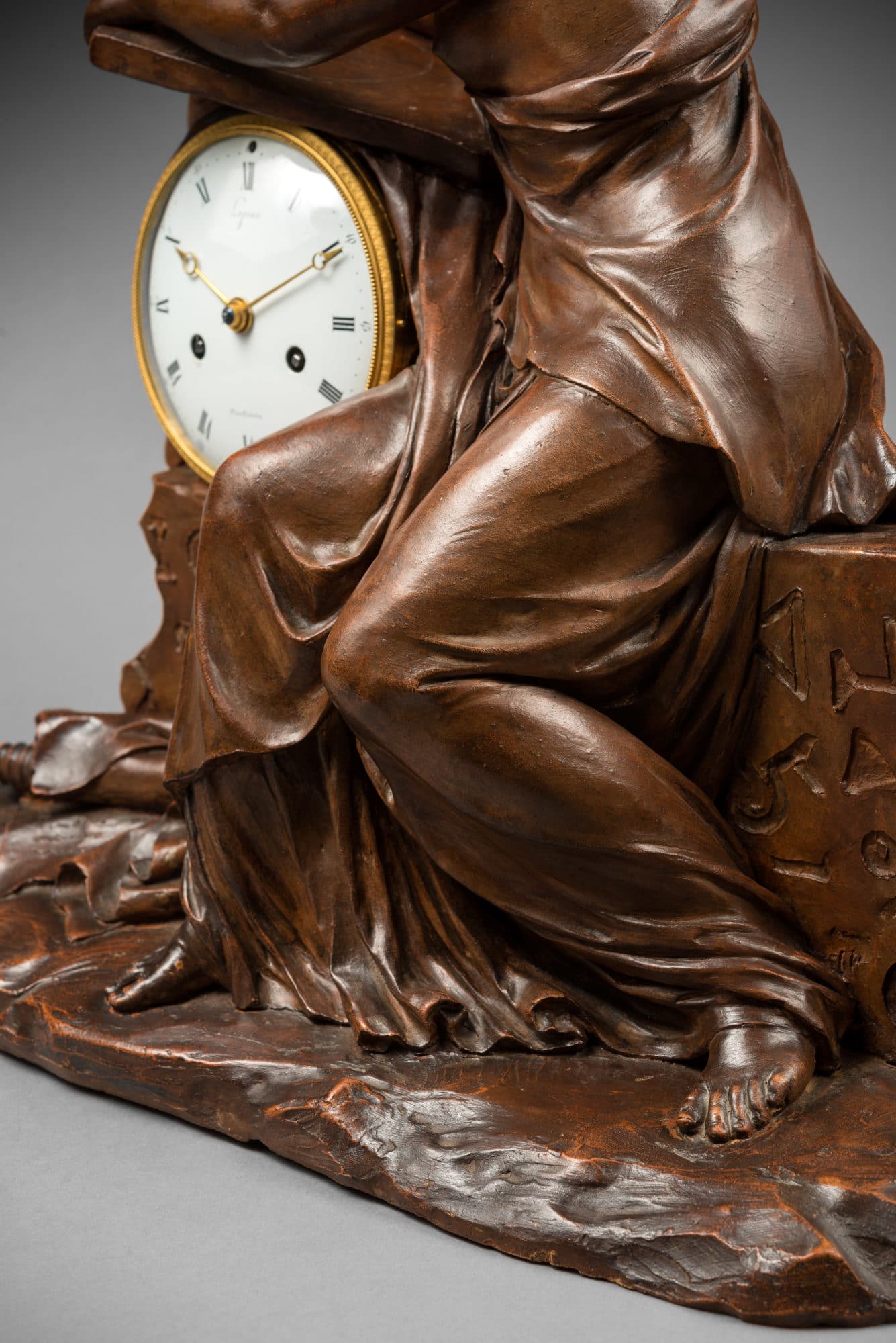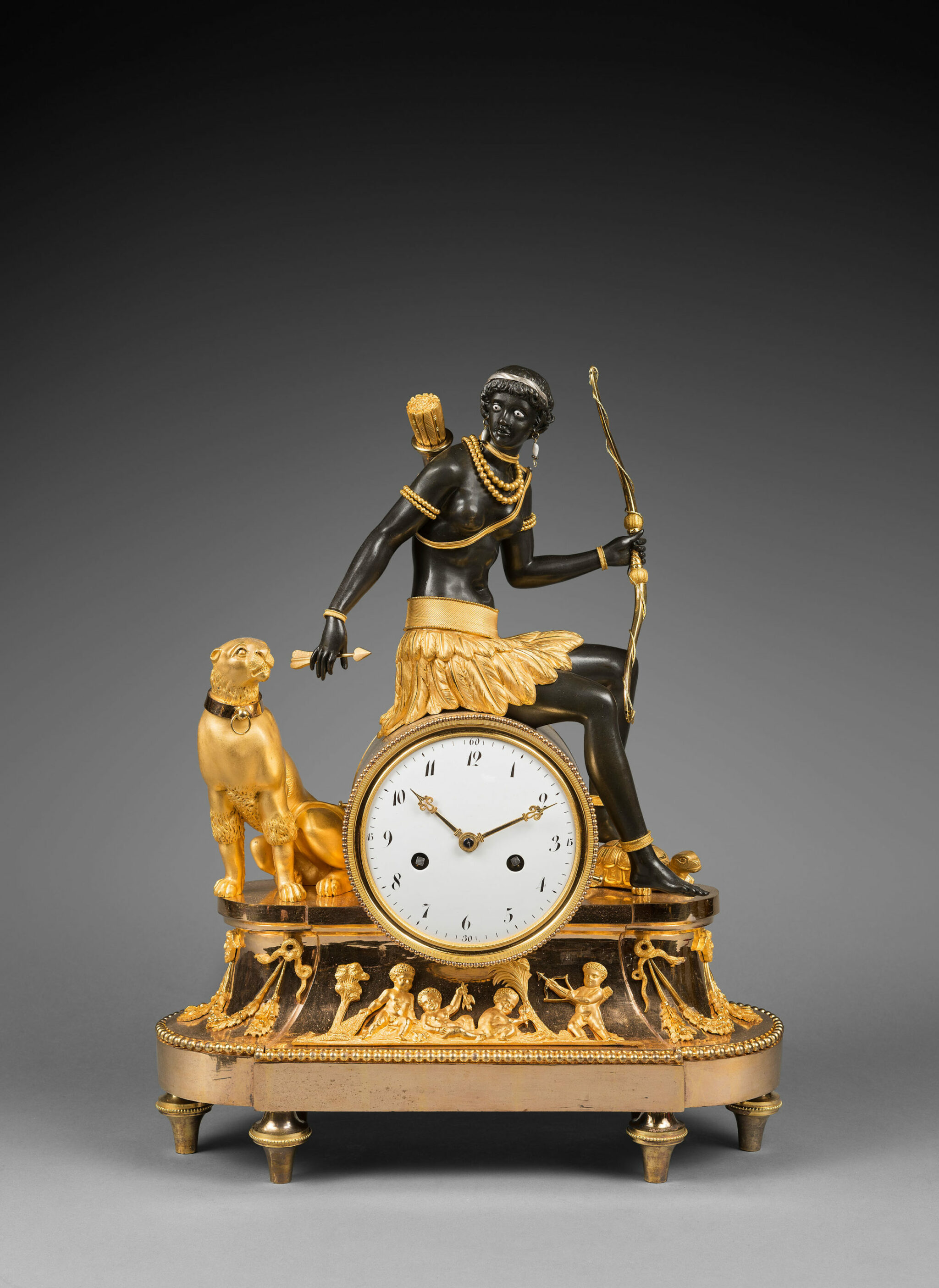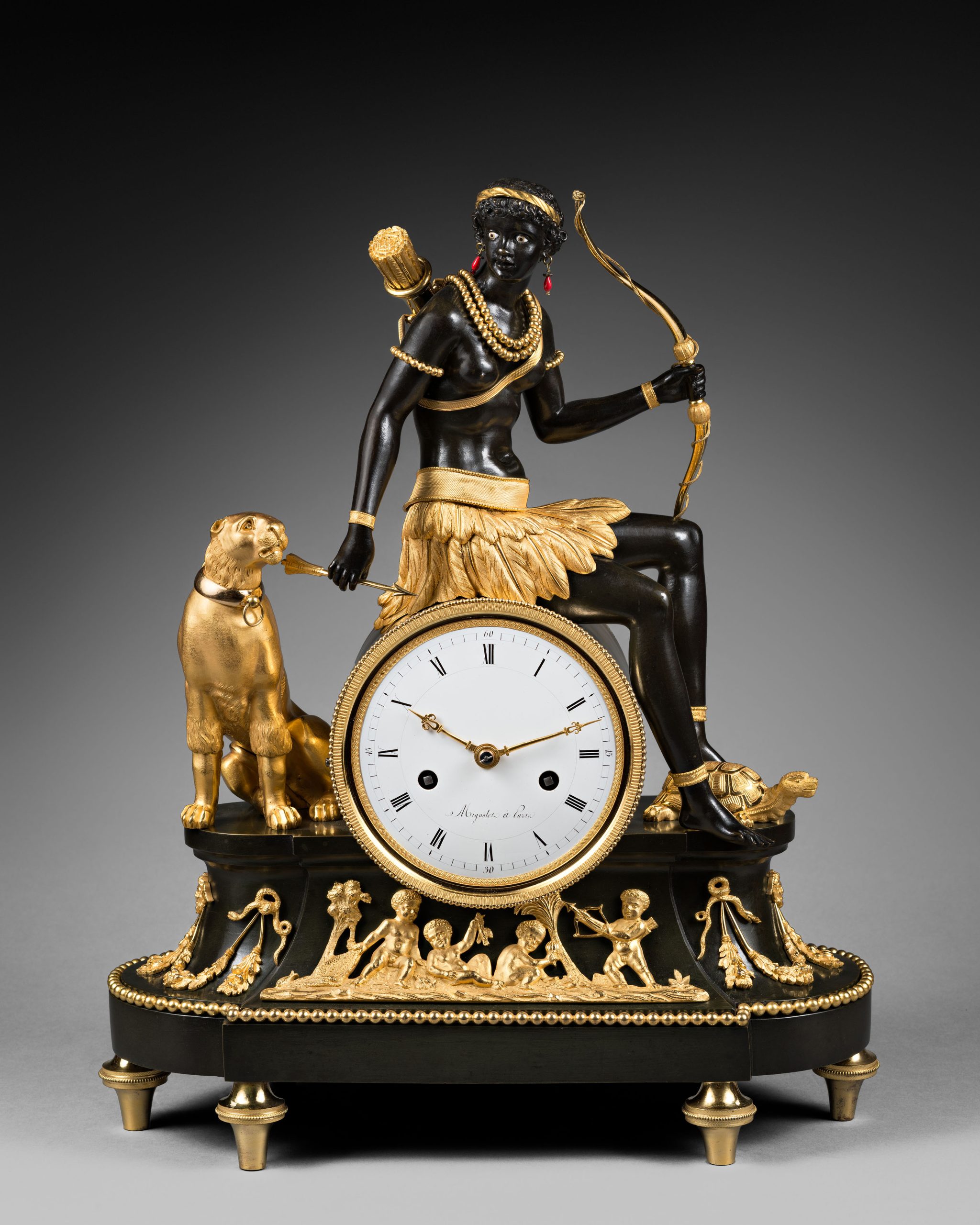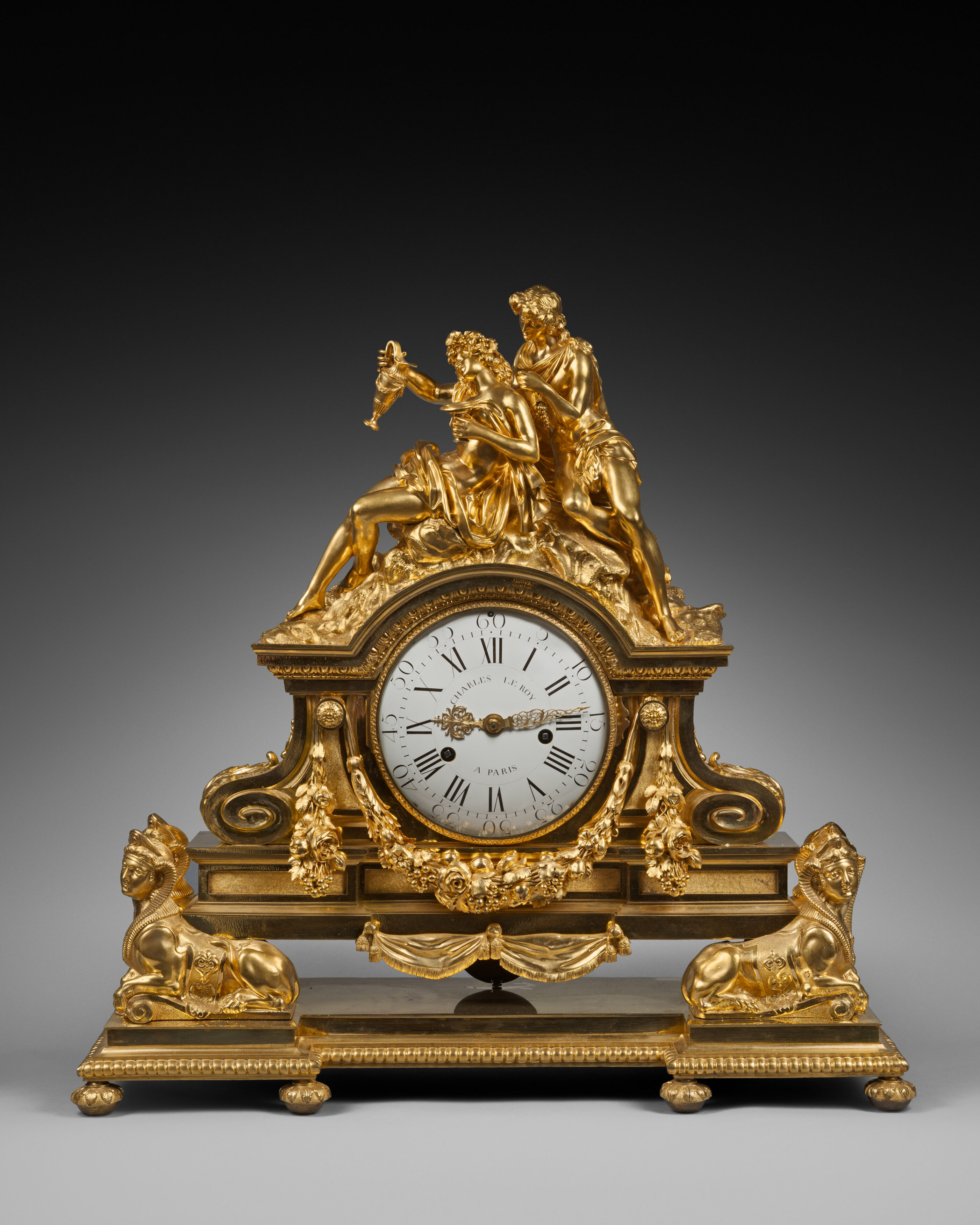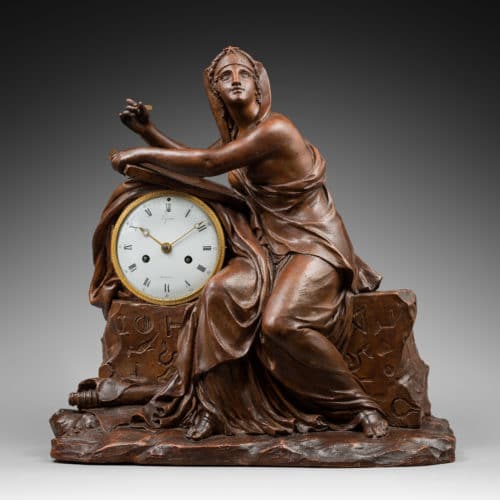Rare Terra Cotta “Egyptian” Mantel Clock
“Egyptian Urania or Allegory of Geometry“
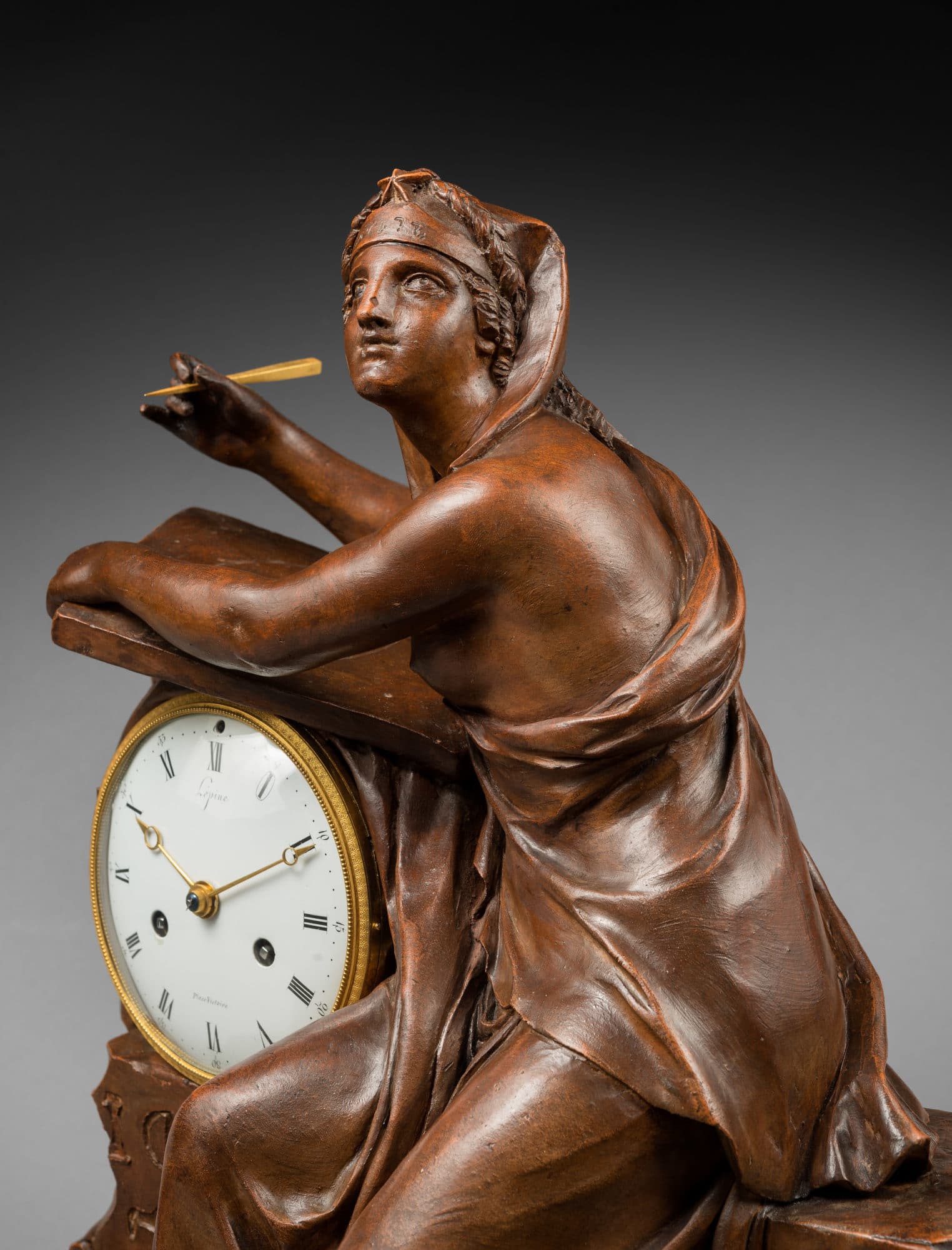
Terra Cotta Case Attributed to Louis-Simon Boizot or his Workshop
Paris, Consulate period, circa 1800
The round enamel dial, signed “Lepine Place Victoire”, indicates the hours in Roman numerals and the five-minute intervals in Arabic numerals, by means of two gilt bronze Breguet hands. The very fine case modelled entirely in patinated terra cotta; the gilt bronze bezel is chased with beading and a frieze of stylised motifs. The whole rests upon a fragmentary stele or antique cippus, that is engraved with Egyptian hieroglyphs and covered by a drapery issuing from the long tunic worn by the seated female figure. Her drapery partially reveals her breasts; she is wearing an Egyptian nemes headdress with a central star and a band with hieroglyphs on her forehead. She is turning toward the spectator and tracing a geometric figure on parchment with a stylus. At her feet lies a pole wrapped with a parchment that is covered with faint inscriptions. The base is treated naturalistically, in an imitation of rocks with scattered, stylised tufts of grass.
Discover our entire collection of antique mantel clocks for sale online or at the gallery.
La Pendulerie is the specialist in fine and rare antique clocks, based in Paris.
The unusual design of this clock illustrates the influence of Egyptian culture on the French decorative arts, as a result of the well-known Egyptian Campaign led by Napoleon Bonaparte from 1798 to 1801. This campaign, the aim of which was to seize control of the Orient, gave rise to a new trend: Egyptomania, or the fascination by Europeans for the culture, the history, and arts of ancient Egypt. The clock’s material, terra cotta, is also unusual. At the time, the great majority of clocks were made of marble and gilt and/or patinated bronze. The fact that the present clock was modelled in terra cotta may suggest that the sculptor later intended to cast the model – though perfectly finished in its present state – in bronze, at a later date. This hypothesis is supported by the existence of a nearly identical type of clock in marble and bronze, an example of which is in the collections of the Geneva Musée d’art et d’histoire (illustrated in H. Ottomeyer and P. Pröschel, Vergoldete Bronzen, Band I, Munich, 1986, p. 338).
The attribution of this model to Louis-Simon Boizot or his workshop is suggested by the exceptional creativity of that workshop; Boizot was one of the principal proponents of the Egyptian style in Parisian horology at the time. He created several unusual clocks with Egyptian figures, which were subsequently cast by talented bronziers such as François Rémond. One such example was created by Boizot and cast by Rémond; it is today in the Prague Museum of Decorative Arts (see the exhibition catalogue Louis-Simon Boizot (1743-1809), Musée Lambinet, Versailles, 2002, p. 292).
Royal clockmaker Pierre-Claude Raguet, known as Raguet-Lépine after his father-in-law Jean-Antoine I Lépine, with whom he worked closely, he was born in Dôle, and in 1782 married Jean-Antoine’s daughter Pauline. Having already invested 16,000 livres in his future father-in law’s business, he purchased a third share in 1783 and eventually took over the business in June 1784, using the name “Lépine à Paris, Horloger du Roi”. Raguet-Lépine was a member of the jury responsible for choosing a new Republican time system (1793); in 1805 he became Horloger breveté de Sa Majesté l’Impératrice-Reine, and four years later was named Horloger de l’Impératrice Joséphine. His clientele included Napoleon I, Jérôme, King of Westphalia, Charles IV King of Spain, the princes Talleyrand, Kourakine (the Russian Ambassador) Schwarzenberg (the Austrian Ambassador), the comte de Provence and Louis XV’s daughters at the Château de Bellevue.
Due to his success he employed a large workforce, including several of his family-in-law: Jean-Antoine II Lépine who managed the workshop, Jean-Louis Lépine in Geneva and Jacques Lépine in Kassel, Germany. His cases were supplied by the renowned bronziers Pierre-Philippe Thomire, F. Rémond, F. Vion, E. Martincourt, the Feuchères and Duports; his dials by such fine enamellists as Coteau, Dubuisson, Cave, Merlet and Barbichon. Today Raguet-Lépine’s work may be seen in the Louvre, the Château de Compiègne, the British Royal Collection, the Musée International d’Horlogerie at La Chaux-de-Fonds, the Deutsches Uhrenmuseum Furtwangen, the Schloss Wilhemshöhe Kassel, the Patrimonio Nacional in Spain, the Hermitage in Saint Petersburg, the Detroit Institute of Arts and the Minneapolis Institute of Arts.
Louis-Simon Boizot (1743 - 1809)
The son of Antoine Boizot, a designer at the Gobelins tapestry manufacture, Boizot worked in the atelier of sculptor René-Michel Slodtz (1705–1764), who also trained Houdon. Boizot married Marguerite Virginie Guibert, the daughter of sculptor Honoré Guibert. In 1778 he was admitted to the Académie royale de peinture et de sculpture and exhibited at the yearly salons until 1800. His portrait busts of Louis XVI and Joseph II were created in 1777 and made in bisque porcelain at Sèvres.
From 1773 to 1800 Boizot directed the sculpture workshop of the Sèvres porcelain Manufactory, producing the series of unglazed biscuit figures with a matte finish resembling that of marble.
Boizot also created terracotta designs for gilt-bronze clock cases, such as that of the allegorical “Avignon” clock in the Wallace Collection in London, which was cast and chased by Pierre Gouthière in 1777.
